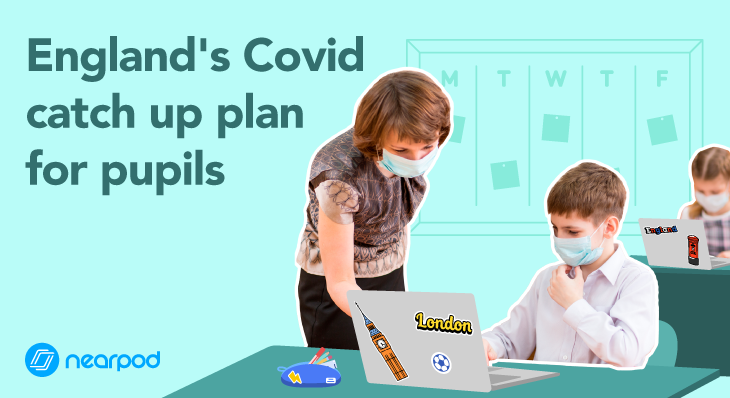
England’s Covid catch up plan for pupils
Don’t return to normal, reboot it.
2020 brought into the national consciousness many things. The effectiveness of a three part slogan, how many times a centenarian can lap his own garden, and just how close to us an unmasked member of the public can stand to us before we feel the need to to tell them to “back off”. There has also been the rise of some new phrases in the modern vernacular. Furlough, distance working, lateral flow and lost learning.
That last one sticks with me a little bit.
“Lost learning”.
As if learning is a set of car keys or your new varifocals. In my opinion parents and teachers have been nothing short of heroic in their efforts to maintain some semblance of normalcy for the millions of children for whom the last 12 months has been a rollercoaster of zoom assemblies, socially distanced classrooms and adding increasingly complex lyrics to the time they spend washing their hands. To suggest they have “lost learning” implies blame on the students for not working hard enough. In my opinion a better phrase would be stolen education. Children have had these opportunities taken from them by circumstances far beyond their control. They are not to blame. So how can we rectify this? How can we give our students, our children, the time and educational input they have been so cruelly denied? The short answer is, we can’t. That time has passed and, short of Elon Musk building a DeLorean factory and perfecting the flux capacitor, we won’t have that time again.
We need to look at how we can be smarter with the time we will have with our pupils in the future. To ensure that we give them an experience that not only replaces those educational opportunities they have had taken from them by the pandemic, but gives them greater experiences and deeper learning opportunities than before. The UK government has announced funding for schools to help pupils to recover some of their stolen education through access to private tutors or online “catch-up” programmes. Schools can use the funds at their own discretion and will most likely be looking for the best way to support not only their most vulnerable pupils but enhance education across the school. This is where I believe Nearpod comes in and the greater value it can bring to a school beyond catch up learning.
Nearpod’s blend of live and self paced presentations means teachers can apply nearpod lessons across a range of situations. Users can create a custom program of lessons for a group of children based on the child’s specific needs. Lessons which record student efforts through activities such as the draw it and quiz functions. This allows teachers to assess pupils’ understanding quickly and with low stakes assessments to ensure that any gaps in their understanding can be treated quickly and efficiently. With a shared school library teachers can pick and choose lessons created by their colleagues meaning content creation workload can be shared easily. Content creation is simplified by the ability to upload any PDF or PPT file into Nearpod and have the slides be converted into Nearpod format automatically. In my experience when introducing teachers to Nearpod it is the simple and easy way presentations are created from existing material that most catches their attention.
Teachers can embed questions into videos of any length meaning pupils’ understanding can be assessed as they are working through instructional material. I have found this tool to be of great use when creating materials for schools as the video source can come from pretty much anywhere, youtube, my local device or from Nearpod’s growing library of custom videos.
Nearpod doesn’t just have to be used for “catch up” lessons either, as the engaging content available within the platform makes it great for live teaching and self paced homework assignments. The integrated 360 photo viewer brings pupils closer to places they have never been, particularly when school trips are not currently on the cards. The array of activities that allow for pupil feedback and input help create a discourse with pupils and can be tailored to pretty much any situation or topic. From collaborative pin boards for class brainstorming activities to long answer questions which allow pupils to convey their thoughts either through text or using the built in audio recorded.
In schools I have worked with that have adopted Nearpod, they have seen key uses for the tool across the curriculum beyond using the self paced lessons for catch up materials. A quick Nearpod presentation at the start of the topic captures that pre learning snapshot of pupil understanding, the questions pupils want to answer and the engagement to get pupils excited about a topic. Resources can then be manipulated in the Nearpod editor to meet the needs of the pupils based on this initial assessment.
In a post home learning world, where there is still the very real possibility of national Lockdowns or isolating families, Nearpod allows the same content to be set for both home learners and the pupils participating live. Lockdown has brought inclusive remote technologies to the fore, Nearpod being one of these and to turn our back on these applications now that our pupils see them as a fundamental part of their toolkit would be folly. We must capitalise on the progress made in the implementation of key educational technologies across our schools and use them to help our students claim back the education stolen from them by the pandemic. Make these tools work for us so we can gain the best advantage for our pupils and help them progress further and aim higher. The pandemic has stolen part of this generation’s education, but technology has given us the tools to take it back and give students even more.
Embrace technology. Increase Engagement. Reclaim Education.

Philip is a well established educator and consultant, with over a decade of experience across all levels of education. He is passionate about bringing technology into the curriculum in an engaging and meaningful way. He is currently a consultant for hi-impact consultancy where he works with schools and educators to implement technology effectively. He is exploring the integration of virtual and mixed reality within education and can often be found experimenting with the latest VR/XR tools.








